The doctor is in – in the kitchen that is
Everyone has to eat, but these UArizona Health Sciences faculty members take their cooking to another level.
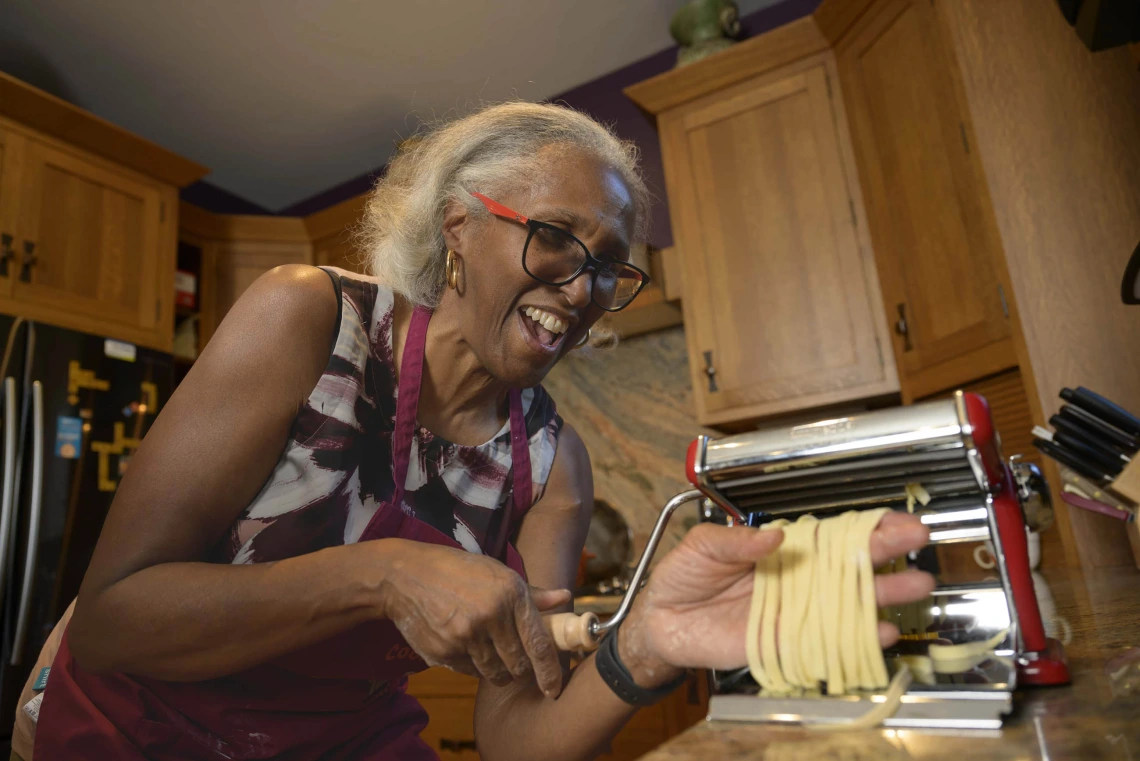
When Juanita Merchant, MD, PhD, threw a recent dinner party, she recreated a meal she’d made in Sicily, complete with homemade pasta.
They spend their days teaching students, doing research, caring for patients and even running a foundation. But off duty, they swap medicine for mise en place, a fancy French phrase that needs no explanation for these University of Arizona Health Sciences faculty members. (For the rest of us, it refers to the setup and preparation work required before cooking.)
After a long day at the office, prepping a meal — with its requisite chopping, stirring and sautéing — is the perfect way to destress for many faculty and staff members. Food is more than just a pathway to health, it’s a beeline to relaxation. When it comes to cooking, the doctor is in – the kitchen.
“Food is … nourishment and pleasure.” – Andrew Weil, MD
When he was a kid, Weil’s mom shooed him away from the stove.
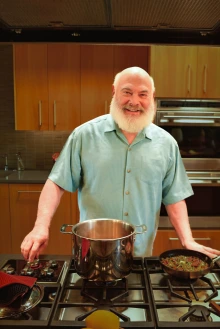
Andrew Weil, MD, loves to invent recipes and says one of his favorites is vegetarian chopped liver. (Courtesy Healthy Lifestyle Brands)
“She said I should be playing outside,” he said with a chuckle.
His paternal grandmother, though, always obliged him. She let him help as she grated fresh coconut and rolled out dough for a cream pie.
“Oh my gosh, that was my favorite thing,” said Weil, founder and director of the University of Arizona Andrew Weil Center for Integrative Medicine, where he also holds the Lovell-Jones Endowed Chair in Integrative Medicine and is clinical professor of medicine in the UArizona College of Medicine – Tucson and public health in the Mel and Enid Zuckerman College of Public Health.
By the time he was in medical school at Harvard University, Weil found cooking to be the perfect way to unwind and whisked his way through Julia Child’s “Mastering the Art of French Cooking.” Weil, the founder and chairman of the Weil Foundation, welcomes everyone into his kitchen and counts his daughter Diana along with coworker and neighbor Anne Marie Chiasson, MD, MPH, CCFP, among his regular sous-chefs.
“I love cooking with other people,” he said. “I think it’s a very good test of social relations to be able to get along in the kitchen.”
Weil, a pescatarian who will admit to licking his plate clean after a fabulous meal, names cheese and dark chocolate as weaknesses. He is picky about his pizza. He prefers Neapolitan-style pie and fires his own at home in a portable pizza oven. He’s a fan of the basic margherita, but also makes one with fried pistachios, red onions and smoked mozzarella — a riff on a pizza by James Beard Award-winning chef and restaurateur Chris Bianco, whose eponymous Pizzeria Bianco is steps away from the Phoenix Bioscience Core.
Weil, founder and partner in True Food Kitchen restaurants, which recently opened a location at La Encantada in Tucson, has hobnobbed with some biggies in the culinary world. Bianco? Weil cooked him pasta. He’s also fed renowned New York chef David Bouley and the late Judith Jones, the book editor who discovered Child.
So, who would be his dream dinner guests?
“I just like to cook for people who appreciate good food,” he said. He counts his two Rhodesian Ridgebacks among the lucky ones who get to taste test his work.
Here’s a tip, though. Should you manage to wrangle a Weil dinner invitation, don’t talk with your mouth full – or at all.
“A sign that my food is really good is that people don’t talk when they’re eating it,” he said. “And often, if I’ve made something really special and people talk through eating it, they’re not invited back.”
“Food is … therapeutic.” – Juanita Merchant, MD, PhD
Travel and food go together like cherries and chocolate, one of Merchant’s favorite combos.
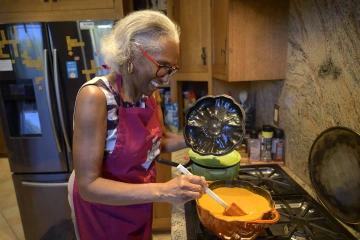
Juanita Merchant, MD, PhD, grew up on hearty Midwestern fare but loves Italian cooking the most.
Wherever she goes, Merchant, interim director of the UArizona Cancer Center, takes a cooking class if she can. She’s cooked up cactus in Cancún, squash soup in South Carolina and swordfish involtini and fresh pasta in Sicily.
To her, cooking is an adventure.
“It’s just another way of learning the history and the culture of an area,” said Merchant, a Regents’ Professor of Medicine and chief of the UArizona College of Medicine – Tucson’s Division of Gastroenterology and Hepatology.
When Merchant was growing up, girls had to take home economics in middle school, so she learned to sew and make applesauce and biscuits. As an undergraduate at Stanford, she landed in an apartment with a kitchen and discovered home cooking was healthier and more economical. She would still eat out at a favorite neighborhood Chinese restaurant but then ask for the recipes so she could recreate moo shu pork and orange chicken.
When she was in medical school at Yale and couldn’t afford to fly home to Los Angeles at Thanksgiving, Merchant turned to a labor-intensive turkey recipe she ripped out of the pages of the Boston Globe. It called for a 24-hour brine. The centerpiece wowed her fellow stranded students and is a staple on her holiday table to this day.
“It’s $50 worth of ingredients, just for the marinade,” she said, ticking off a list that includes soy sauce, white wine, honey and juniper berries. “I always get compliments on it. The breast is not only tender but it’s just very flavorful.”
While Merchant has an adventurous palate, she drew the line at an opportunity to sample grasshoppers in Texas. She also isn’t a fan of heavy cream sauces.
“I’m lactose intolerant,” she said, but she does love butter.
As a general rule, Merchant gravitates toward Asian and Italian dishes. As a kid growing up with a mother from the Midwest, she ate a lot of meat-and-potatoes fare. Though her mom passed along a killer recipe for pie crust – “Just Crisco and flour and water and salt” – Merchant figures baking is the only real hitch in her cooking repertoire. She once made a German chocolate cake for a dinner party and it didn’t rise. Merchant frosted it anyway and the cake looked beautiful, but when her friend cut into it. …
“The look on her face,” Merchant said, laughing at the memory. “Oh, nobody was going to eat that.”
“Food is … a source of physical, spiritual and cultural sustenance.” – Alon Kol, DPM, FACFAS, FACPM
Kol has cooked his whole life.
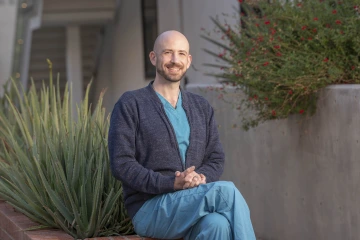
Alon Kol, DPM, FACFAS, FACPM, loved PBS cooking shows as a kid and regularly made dinner for his parents.
Well, almost.
Truth be told, he slacked off in those early years. But family legend has it that by the age of 3 or 4, little Alon begged to be part of some kitchen action one day when his parents were fixing tuna salad. Eventually, they relented.
“I cut all my fingers, but I made the tuna salad,” said Kol, who last year joined UArizona as a clinical assistant professor and section chief of podiatry for the College of Medicine – Tucson. “I don’t know a time that I wasn’t cooking.”
Kol, a latchkey kid, was regularly preparing the family’s Orthodox Jewish meals. He watched PBS cooking shows and idolized the chefs so much that for his birthday he asked for a Chinese chef’s knife just like Martin Yan used on “Yan Can Cook.”
As someone who enjoys disassembling and fixing things, it’s no surprise he’s drawn to the kitchen. Cooking feels similar.
Ask him about his favorite ingredient and he smiles.
“Is it wrong to say oil?” he asked. “It’s probably my favorite. I love to make fried foods.”
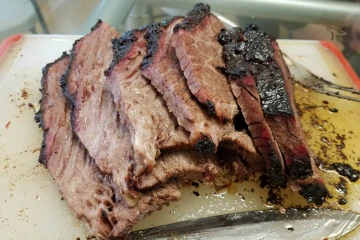
Kol and his wife participated in competitive kosher barbecuing when they lived in New York. (Courtesy Alon Kol)
Especially latkes. Kol said his family’s simple recipe for potato pancakes is, hands down, the best. And he knows this for certain because he’s tried all the latke recipes in his extensive kosher cookbook collection. The two tricks are squeezing the excess moisture from the shredded potatoes and then having enough potato starch to bind the cake together.
“You end up with this wonderful crispness,” he said. “You know how you have those potato chips when you’re a kid? The shoestring potatoes? That’s what it ends up like.”
As transplants to Tucson, Kol and his wife, Yamit, are loving the food scene, happily exploring Mexican food and rating their top salsas. Just hold the cilantro, please.
“I guess I’m one of those people who taste soap,” Kol said.
He said they’re still on the hunt for great barbecue, but, to be fair, they set a pretty high bar based on their days of competitive kosher barbecuing in New York, where they’d smoke brisket, chicken and ribs, and everyone would be up in the middle of the night for the 16-hour cook.
“All of your clothes, every inch of you, just reeks of barbecue smoke at the end of that day,” said Kol. “But God, it’s just such an amazing way to spend time.”
“Food is … a love story of culture, people and creativity. Food is the thing that connects all cultures – it’s part art form, part history, part emotion.” – Purnima Madhivanan, PhD, MBBS, MPH
When it comes to cooking, Madhivanan is willing to take some risks. She’s not a by-the-cookbook kind of person.
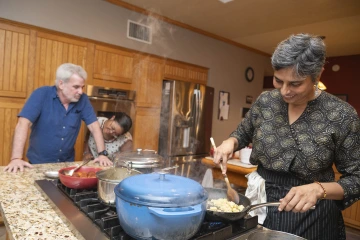
Purnima Madhivanan, PhD, MBBS, MPH, loves to improvise when she cooks.
“I can’t stick to recipes,” said the associate professor of health promotion in the Zuckerman College of Public Health. “Cooking wouldn’t be fun and it wouldn’t be the journey of discovery I enjoy. Of course, there’s always risk. It wouldn’t be as exciting unless you have the chance to fail.”
Or get stopped by airport security.
An avid traveler, Madhivanan loves to soak up culture through local markets and cooking classes and brings home souvenirs like fresh spices. For a while, she’d tuck traditional Indian yogurt starter — wrapped in multiple layers of plastic to hide the smell — deep into her suitcase.
“Several times I had to hold my breath as they led their dogs to smell different customers’ luggage,” said Madhivanan, who is also a member of the Cancer Center and BIO5 Institute. “Thankfully, they didn’t sniff my luggage and I was able to get years of yogurt out of the starters I brought in.”
She’s dined at Michelin-starred restaurants, but Madhivanan loves to seek out the hole-in-the-wall places where the locals eat.
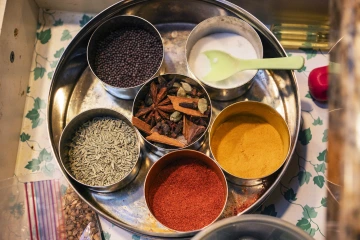
Madhivanan makes a point of taking cooking classes and visiting food markets wherever she goes. She loves bringing home spices as souvenirs from her travels.
In October, she traveled to France, where she savored buttery croissants. In Genoa, Italy, she dined on pesto Genovese, a handmade pasta topped with a raw sauce redolent of garlic and brimming with basil, pine nuts, Parmesan and Pecorino cheeses, and extra virgin olive oil; focaccia; and Stoccafisso alla Genovese, a Ligurian dish of salted cod, potatoes, olives, tomatoes, onions and herbs.
“It was spectacular,” said Madhivanan, the director for the Global Health Equity Scholars Fellowship Program.
As the middle of three children, Madhivanan grew up studying at the kitchen table while her mother made fish curry and steamed sweet and savory dumplings. Devouring the wonderful, home-style Indian meals motivated Madhivanan to learn to cook when she got older. Well, that plus the terrible food that came out of the college dining hall.
“I think what really resonates with me about cooking is the creativity and the fusion of science and art,” she said. “It's like this beautiful symphony where you combine various ingredients, techniques and flavors to create something entirely new. I can express myself and craft something that I infuse with my personality and style.
“There's also something magical about the transformation from raw ingredients into fully developed flavors. The way aromas fill the kitchen, the colors blend and the flavors harmonize — it’s a sensory experience that engages every sense. Moreover, cooking has the ability to bring people together. Whether you're cooking for yourself or for others, there's a joy in sharing the results. It's a universal language transcending barriers and connecting people.”
Kol Family Latkes
Serves 6, with 2-3 latkes per person
Courtesy of Alon Kol, DPM, FACFAS, FACPM
Says Kol: “So this is a bit of a recipe like you would get from babi (grandmother). The proportions are rough estimates that are open to interpretation to the cook’s preference. There are very few ingredients – it is mostly about technique.”
9 medium potatoes
2 medium onions
3 eggs
potato starch (saved from the grated potatoes)
vegetable oil
Using a box grater with medium size holes, grate the potatoes.
Use a towel to squeeze a few large handfuls of shredded potatoes at a time; ring out water from the potatoes into a bowl. Place potatoes in another bowl.
Slice onions into ¼ moon (or smaller) pieces; slice thinly.
Add eggs and onions to the bowl with potatoes.
The bowl of water that you squeezed from the potatoes will have potato starch caked on the bottom. Add approximately half the starch. Then add more gradually, as needed, to achieve good cohesion.
The potato mixture is ready when it can be formed into a ball and retain its shape.
Pour vegetable oil into a skillet, about ¼-inch deep, and heat to medium high.
Take a handful of the potato mixture and squeeze to get more water out.
Place the formed ball into the oil and use a spatula to flatten it.
Cook about 2 to 3 minutes per side or until golden brown; remove latkes to wire rack or paper towels and salt to your preference
Serve with any dip or topping. Applesauce is traditional.

